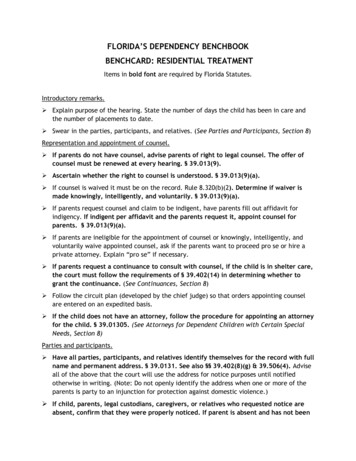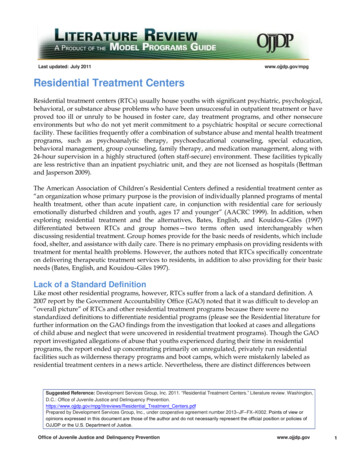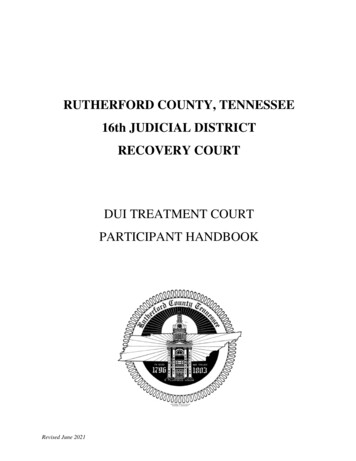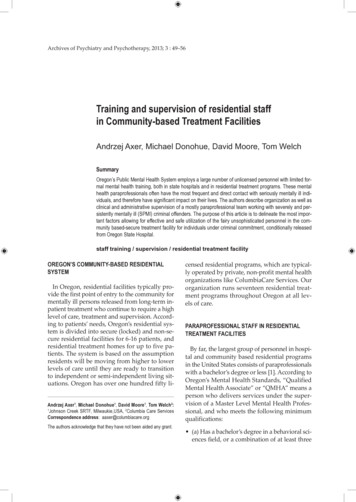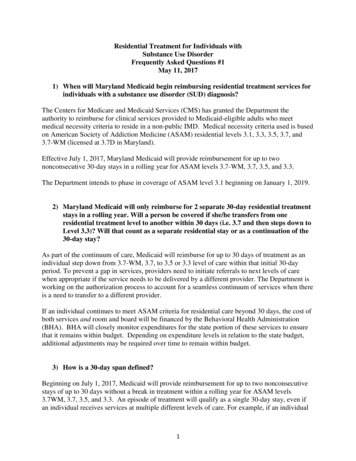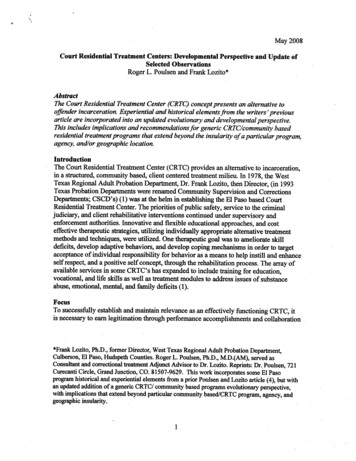
Transcription
,\ ,IMay 2008Court Residential Treatment Centers: Developmental Perspective and Update ofSelected ObservationsRoger L. Poulsen and Frank Lozito·AbstractThe Court Residential Treatment Center (CRTC) concept presents an alternative tooffender incarceration. Experiential and historical elements from the writers' previousarticle are incorporated into an updated evolutionary and developmental perspective.This includes implications and recommendations for generic CRTC/community basedresidential treatment programs that extend beyond the insularity ofa particular program,agency, and/or geographic location.IntroductionThe Court Residential Treatment Center (CRTC) provides an alternative to incarceration,in a structured, COmnll.ullty based, client centere4 treatment milieu. In 1978, the WestTexas Regional Adult Probation Department, Dr. Frank Lozito, then Director, (in 1993Texas Probation Departments were renamed Community Supervision and CorrectionsDepartments; CSCD's) (1) was at the helm in establishing the El Paso based CourtResidential Treatment Center. The priorities of public safety, service to the criminaljudiciary, and client rehabilitative interventions continued under supervisory andenforcement authorities. Innovative and flexible educational approaches, and costeffective therapeutic strategies, utilizing individually appropriate alternative treatmentmethods and techniques, were utilized. One therapeutic goal was to ameliorate skilldeficits, develop adaptive behaviors, and develop coping mechanisms in order to targetacceptance of individual responsibility for behavior as a means to help instill and enhanceself respect,anda positive self concept, through the rehabilitation process. The array ofavailable services in some CRTC's has expanded to include training for education,vocational, and life skills as well as treatment modules to address issues of substanceabuse, emotional, mental, and family deficits (1).FocusTo successfully establish and maintain relevance as an effectively functioning CRTC, itis necessary to earn legitimation through performance accomplishments and collaboration*Frank Lozito, Ph.D., former Director, West Texas Regional Adult Probation Department,Culberson, EI Paso, Hudspeth Counties. Roger L. Poulsen, PhD., MD.(AM), served asConsultant and correctional treatment Adjunct Advisor to Dr. Lozito. Reprints: Dr. Poulsen, 721Curecanti Circle, Grand Junction, CO. 81507-9629. This work incorporates some EI Pasoprogram historical and experiential elements from a prior Poulsen and Lozito article (4), but withan updated addition of a generic CRTC/ community based programs evolutionary perspective,with implications that extend beyond particular community basedlCRTC program, agency, andgeographic insularity.1
with constituents, local, state, federal and international resources. The multifacetedaspects of CRTC and community based program constructs encompass judges, criminaljustice system personnel, administrators, other public officials, clients, families,academicians, additional resource experts, volunteers, and indeed total resident and localcommunity program support (2). Accordingly, constituencies need to be readily informedabout program purpose, value, and attendant goals and objectives. Moreover, a cohesive,unified, focus in community based correctional programs is needed to counteract anebulous public image (3). In particular, the value of the judiciary is still recognizedrelative to its key role and acknowledged significance for program formation, support anddevelopment. Although findings about cost of community based programs havesometimes been characterized as inconclusive (2), it is likely that they are less expensiveto operate than state institutions (5). Of additional interest, is the always relevant questionabout cost effectiveness, particularly in light of the variety and burgeoning number ofalternative community based programs and the omnipresent issue of recidivism and costfor offender institutionalization. Moreover, although relevant, other variables anddimensions, other than cost, associated with CRTC's/community based programs, may beless objective and can vary according to perception (6), for example, humanitarianaspects regarding program, treatment, and process, as well as attitudes and public imagein relation to offender, victim, family, citizen, and program staff. Some of these are notalways readily apparent nor easily assessed in either the short or longer term time frames.Nevertheless, over and above singular quanti tive measures, other less objective factorsshould not be ignored among the mix of salient variables. These may provide a tenablesupplementary rationale for executive decision making and policies that support use oflimited agency and program resources in a daily operational environment. Thus,emphasis upon the program's visible humanitarian treatment/prevention value, in tandemwith potential CRTC cost benefit/cost effectiveness data/projections, in contrast to moreunidimensional custodial and societal lost productivity costs from incarceration, may beuseful. These can be applied to demonstrate tangible and practi al multidimensional .benefits that may accrue from community based programs. This contention is bolsteredwithin a perspective of long range planning, wherein goals of local community basedprograms are to reduce growth, control costs, maintain and enhance quality control, andpromote the phase out of some other components of the traditional criminal justicesystem (7).Developmental PerspectiveSince inception of CRTC's, perhaps evolution is more apparent, not so much with regardto their concept and nascent stages of development, but rather in relation to the context ofthe larger· criminal justice system, in some locations, and selected entities and elementswithin the operational environment for CRTC's/community based programs. Forexample, in Texas May, 2000, there were reportedly thirty nine community correctionsfacilities, including a half dozen combination facilities with different bed types andcombinations of categorical programs (1). Expansion of alternative community basedprograms, in addition to CRTC's, reveals Substance Abuse Treatment Facilities(SATF's), Restitution Centers (RC's for offenders with problems satisfying court orderedfinancial obligations and unemployment issues), Local Boot Camps (LBC's based uponmilitary basic training and applicable to first time offenders), and Intermediate Sanctions2
Facilities (ISF's for supervision of violators as a court incarceration option short ofrevocation and institUtionalization) (1). Also, in 1993, Texas converted sentencing lawsthrough origination of new felony category (State Jail Felony) to circumvent prison forlow level property and drug offenders (1). Other changes/issues have occurred that mayimpact CRTC's/community based programs. Some of these are: increased publicawareness and media publicity concerning offender and victim rights within theframework of civil and individual rights and "entitlements"; heightened community andpolitical pressure for public safety and law enforcement; effective but humane treatmentmodalities for rehabilitation, with heightened monitoring and closer scrutiny of specificsby the public, professionals, and clients/client families and friends; requiredadministrative capability to demonstrate positive outcomes for return on taxpayerinvestment. Additional developments reflect refinement and redesign of communitybased programs. As an example, Texas state efforts have included professional and staffskill set training, innovation and improvement in utilizing research based treatmentapproaches and validated program curricula (e.g., proposed experimental aural-visualchannels of learning) (4,8), risk assessment to gauge and appropriately n:tatch offenderand level of program intensity (8), and evaluation of treatment needs for inclusion ofinterventions that circumscribe values, peers, problem solving, criminal behaviors, andrelapse (8).aLeadershipPersonal qualities, attributes and skills requisite for CRTC/community based programleaders and staff are enumerated and previously discussed by the authors (4). Planning,staffing, organizing, directing, and controlling remain as cardinal managerial principlesnot uncommon to effective leadership. Nonetheless, intervening sociopolitical andeconomic variables, both internal and external in origin to a particular program, presentshifting issues and challenges to CRTC/community based program staff.Management Information SystemsIn the sphere of community based residential programs, and indeed the world, changesand exponential advances in information technology such as the internet, and electronicdata processing, have direct impact upon daily tasks in various CRTC's. Informationalboundaries of whatever type and kind are sometimes penetrable, receding, or absent.Accordingly, program issues and confidentiality take on new concerns about access viafreedom of information, transparency policies, and occasional uninvited intrusions.Community based programs are not free from the possibilities of complications resultingfrom awareness, publicity, intrusion and/or scrutiny of special interests.Program EvaluationEvolutionary developments within the criminal justice system, localities, the largersociety, and CRTC/community based programs, have sometimes resulted inreconsideration and realignment of priorities in view of competition for funding andallocation oflimited resources among alternative programs and agencies. Accordingly,there is a shift in program evaluation from a desirable need to a mandatory priority forprogram and management decision makers.3
Community Based Court Residential TreatmentNot unrelated to program evaluative research is the importance of treatment strategies,methods, and techniques for CRTC's/community based programs. Given its significantrole, a summary review and update of current best practices includes certain commonidentifiable principles and functions, useful in charac erizing therapeutic residentialcommunities. In a CRTC, the target of alternative treatment interventions circumscribesvariables of documented salience and priority for selected offenders within the criminaljustice system, e.g., substance abuse (8). Underlying the CRTC therapeutic treatmentmilieu is a theoretical framework melding psychosocial philosophies (10,11). One ofthese variables centers upon a client learning process with emphasis upon more effectivesocial skills, and development of a more secure emotional base, for daily life andvocational functioning (9). An additional philosophical component is based upon apsychodynamic hypothesis which directs attention toward behavioral patterns vis-a.-visthe relationship between individual difficulties with self concept/actions andinterpersonal relations with others as amenable to scrutiny, discussion, analysis,synthesis, understanding, and remediation in a proper environment (12). Milieu therapyvitalpresupposes that a proper environment can exert its own characteristictherapeutic force upon those exposed to it (13). The Court Residential Treatment Centertherapeutic milieu with sanction as a condition of probation andlor parole, differssignificantly from the conventional medical treatment oriented model and also thecustodial nature of the traditional penal institution, each with corresponding treatmentissues and concerns (14). Some characteristics, principles, and functions of a therapeuticmilieu include the following: size most effectively restricted to fewer than 100 clients;alternative treatment modalities utilized for problems with noteworthiness of the socialmethods approach; freeing of communications; frequent daily community client and staffmeetings as a forum for consideration of common problems; provision of protected newlearning experiences for client ego strengthening; encouragement and reward for positivebehavior; confidence in patient capacity for assuming responsibility and initiative;structuring of alternative activities and appropriate work for clients (12). Althoughvarious practitioners, organizations, facilities, institutions, and systems may utilizedifferent treatment plans, philosophies and methodologies, a common goal is to seek adesired therapeutic response to behavioral, medication, or other interventions, atefficacious treatment/dosage levels based upon careful individual client diagnosis andevaluation for behavioral modification (10,15,16). Some additional points have beenreported in relation to two very similar scales for assessing various psychiatric treatmentenvironments (17,18). One of these, the Community Oriented Program EnvironmentScale (COPES), is applicable to transitional community oriented treatment programs andassesses various characteristic dimensions of a therapeutic milieu according to thefollowing subscale categories: ' involvement" (client enthusiasm, attitudes, energy, andinvolvement in day-to-day activities and social functioning); "support" (mutual client-toclient, therapist-to-client, and staff-to-client assistance and encouragement);"spontaneity" (extent of environmental encouragement to act out and freely express clientfeelings toward others); "autonomy" (facilitating patient independence, responsibility,and self direction); "practical orientation" (future orientation, planning, post-release goalsetting, vocational training); "personal problem orientation" (encouragement of problemself-awareness, problem/feelings insight and understanding through client and staffand4
\discussion); "anger and aggression" (allowance and encouragement of emotionalexpression and argumentation); "order and organization" (import of regularity,scheduling, orderliness of the physical environment); "program clarity" (clientknowledge and expectations of daily routing, rules, procedures); "staff control" (extentand necessity of restrictiveness, control sanctions) (18,19).DiscussionIn spite of evolution within the criminal justice system, and some developmental changesin CRTC program content and continuum of services, CRTC's/community basedresidential programs are in general a viable alternative to prison for offenders, e.g.,CRTC programs in Texas (20). Present day operational environments include issues andchallenges exacerbated by contemporary pressures. Nevertheless, the process of programdevelopment is not ideally based upon automatic concessions in response to demands ofspecial interests, without justification. Development of a program component, such asthat focused upon cultural subgroups and ethnic identity (21), needs to be carefullyscrutinized as one element of an interrelated system and treatment plan. Accommodationto pressure, and evolution of program segments, should only occur with it view towardthe likely consequences and costs of achieving client and treatment program goals,potential compromises in integrity of purpose, and undesirable alterations in clientcontrol and the provision of directed growth toward self-actualization. Change shouldmost often be made where there is necessary and sufficient reason to do so, not for thesake of change itself, absent consideration of other possible system effects. Sharpeningand improving appropriate application of attitudes, knowledge, skills, and actions throughin-service training, continuing education, case study use, and organizational informationexchange, within and outside the catchment area, may benefit participants. Awareness ofpossible resources for joint venture affiliation with community, volunteers, and experts(for instance, academic medical centers like the Texas Tech EI Paso satellite program)merits attention of program administrators.Advancements in management information systems and information technology arecrucial to community based programs/CRTC security and client confidentiality.Investigation and use of security firewall software as well as computer programs tofacilitate data retrieval and reduction are recommended. In addition, principles of humansubjects research protections and peer review can be extended, as applicable and ifdesired, to the criminal justice system and community based program domain.CRTC treatment exploration and innovation can draw upon a robust resource baseapplicable to the therapeutic milieu in the residential community setting (CenikorFoundation games, Synanon groups, reality therapy, cognitive behavioral therapies,rational emotive therapy, t group sensitivity training, et al.).The topics of cost control and funding of community based programs is a continuingissue that requires additional work. One proposal for study fu Texas concerns the Ohiomodel where a county account funding system, excluding community safetyincarcerations, funds state incarceration of its offenders. Diversion and communitytreatment programs may be supported with unexpended county funds (20).5
In order to remain competitive, and retain as well as enhance status in the armamentariumof correctional treatment altematives, CRTC and community residential programs requiresolid management, improved cost containment, and responsive program innovations tomeet changing community and offender priorities. Moreover, program development mustbe anchored in a theoretical but practical conceptual framework grounded in findingsfrom quality program evaluative research. Management and other user confidence levels,relative to research findings and outcome measures, can be elevated by attention to andapplication of the scientific method with adherence to applicable steps in the researchprocess. The existing body of knowledge from evaluative research findings is too oftenclouded by issues that include but are not limited to: unclear andlor imprecise problemstatements and operational definitions, poor research design (e.g., small N ambiguity inprotocol that limits reliability, replication, and other than face validity, lack of equivalentand appropriate comparison groups, absence of a control group, ex post factomeasurement at a single point in time without a baseline of research results providing abenchmark from which to gauge progress, and evaluative research that is post hoc innature without a priori formulation and statement of program and research goals andobjectives). As a result, exchange and comparison of useful quality empirical researchdata and information for decision making is thereby limited. Deficits are sometimesneglected or ignored in administrative follow-up or lack of the same.Findings have been reported to indicate that CRTC's and Restitution Centers (RC's)produce a less favorable ratio of offender diversions from prison per 100 beds than doIntermediate Sanction Facilities (ISF) and Substance Abuse Treatment Facilities (SATF).These results note the salience of local discretion as a key variable in programeffectiveness (20). For heuristic purposes, in order to provide additional relevantsuggestions for future residential program development, the need for other evaluativeresearch investigations is indicated to clarify what treatments/interventions are mosteffective, for whom, and at what costs. To this end, employment of formative andsummative program evaluation research, and general systems analysis approaches, areassets (22,23,24).Last, a Spanish philosopher suggested the value of learning lessons from mistakes of thepastin order to avoid future perils (25). Therefore, a CRTC/community based residentialprogram development and problem solving focus, which employs a contemporary unit ofanalysis to reexamine previous issues, problems, and past solutions, may produce freshideas and innovations. Collective efforts to reconsider history in light of currentcircumstances and a situational perspective may benefit extension and enhancement ofeffective Court Residential Treatment Center/alternative community based residentialprogram efforts to benefit offenders, communities, and the larger society.6
In order to remain competitive, and retain as well as enhance status in the armamentariumof correctional treatment altematives, CRTC and community residential programs requiresolid management, improved cost containment, and responsive program innovations tomeet changing community and offender priorities. Moreover, program development mustbe anchored in a theoretical but practical conceptual framework grounded in findingsfrom quality program evaluative research. Management and other user confidence levels,relative to research fmdings and outcome measures, can be elevated by attention to andapplication of the scientific method with adherence to applicable steps in the researchprocess. The existing body of knowledge from evaluative research findings is too oftenclouded by issues that include but are not limited to: unclear andlor imprecise problemstatements and operational definitions, poor research design (e,g., small N ambiguity inprotocol that limits reliability, replication, and other than face validity, lack of equivalentand appropriate comparison groups, absence of a control group, ex post factomeasurement at a single point in time without a baseline of research results providing abenchmark from which to gauge progress, and evaluative research that is post hoc innature without a priori formulation and statement of program and research goals andobjectives). As a result, exchange and comparison of useful quality empirical researchdata and information for decision making is thereby limited. Deficits are sometimesneglected or ignored in administrative follow-up or lack of the same.Findings have been reported to indicate that CRTC's and Restitution Centers (RC's)produce a less favorable ratio of offender diversions from prison per 100 beds than doIntermediate Sanction Facilities (lSF) and Substance Abuse Treatment Facilities (SATF).These results note the salience of local discretion as a key variable in programeffectiveness (20). For heuristic purposes, in order to provide additional relevantsuggestions for future residential program development, the need for other evaluativeresearch investigations is indicated to clarify what treatments/interventions are mosteffective, for whom, and at what costs. To this end, employment of formative andsummative program evaluation research, and general systems analysis approaches, areassets (22,23,24).Last, a Spanish philosopher suggested the value of learning lessons from mistakes of thepastin order to avoid future perils (25). Therefore, a CRTC/community based residentialprogram development and problem solving focus, which employs a contemporary unit ofanalysis to reexamine previous issues, problems, and past solutions, may produce fresh. ideas and innovations. Collective efforts to reconsider history in light of currentcircumstances and a situational perspective may benefit extension and enhancement ofeffective Court Residential Treatment Center/alternative community based residentialprogram efforts to benefit offenders, communities, and the larger society.6
Reference List1. Armbrister K, Duncan R, Nelson J, et al.: Texas senate co:mmjttee on criminaljustice interim report charge 5:1-43, Nov. 1,2000.'2. McSparron J: Community correction and diversion; costs and benefits, subsidy modesand start-up recommendations. Crime and Delinquency 226-247, Ap. 1980.3. Czarnecki A: Building consensus in community corrections. Corrections 86-88, June1983.4. Poulsen R,Lozito F: Court residential treatment centers: selected observations. WestTexas Regional Adult Probation Department Research Monograph Series 1-11, May1984.5. Greenberg F: Problems in community corrections. Issues in Criminology 6, Spring1975.6. Broadstock M, Brinson D, Weston A: The effectiveness of compulsory residentialtreatment of chronic alcohol or drug addiction in non-offenders. Health ServicesAssessment Collaboration, HSAC Report 1(1): 1-157,2008.7. Blackmore J: Minnesota community corrections act takes hold. Corrections 53,March 1978.8. White B, Nagy G, Johnson G, et al.: Report to senate criminal justice interimCommittee; Texas community-based substance abuse treatment program 1-38,March 2002.9. Lehman A, RitzIer B: The therapeutic community inpatient ward: does it reallywork? Comprehensive Psychiatry 17: 755-761, 1976.10. NIDA lnfoFacts: Treatment approaches for drug addiction. National Institute OnDrug Abuse: Rockville, Maryland 1-4, August 2006.11. DHHS Publication No. (SMA)97-3159: The national treatment improvementevaluation study. U. S. Department of Health and Human Services SubstanceAbuse and Mental Health Services Administration, Center for Substance AbuseTreatment, Office of Evaluation, Scientific Analysis and Synthesis 241-242,1997.12. Clark D: The therapeutic community----concept, practice, and future. British Journalof Psychiatry 111: 947-954, 1965.13. Van Putten T: Milieu therapy: contraindications. Archives of General Psychiatry 29:640-643, 1973.14. Butzin C, Martin S, Inciardi J: Treatment during transition from prison to communityand subsequent illicit drug use. Journal of Substance Abuse Treatment 28(4) 351358,2005.15. NIDA InfoFacts: Treatment for drug abusers in the criminal justice system. NationalInstitute On Drug Abuse: Rockville, Maryland 1-3, October 2006.16. NIDA: Principles of drug abuse treatment: a research-based guide. National Institutesof Health, Publication No. 00-4180, U. S. Department of Health and Human Services1-2, 1999.17. Moos R, Houts P: Assessment of the social atmospheres of psychiatric wards. Journalof Abnormal Psychology 73:595-604,1968.18. Moos R: Assessment of the psychosocial environments of community orientedpsychiatric treatment programs. Journal of Abnormal Psychology 79:9-18, 1972.7
19. Steiner H, Haldipur C, Stack L: The acute admission ward as a therapeutic.community. American Journal of Psychiatry 139:901, 1982.20. Fabelo T, Ygnacio R, Barbee A, et al.: Trends, profile and policy issues related tofelony probation revocations in Texas. Criminal Justice Policy Council 1-101,Nlay2002.21. French L: An analysis of contemporary Indianjustice and correctional treatment.Federal Probation 19-23, Sept. 1980.22. SuchmanE: Evaluative Research. New York, Russell Sage Foundation, 1967, 1-186.23. Weiss C: Evaluation Research: Methodology for Assessing Program Effectiveness,Englewood Cliffs, New Jersey, Prentice Hall, Inc., 1972, 1-160.24. Bertalanffy L von: General systems theory and psychiatry. American Handbook ofPsychiatry 3: 705-721, 1959.25. Santayana G: The Life Of Reason, Reason In Common Sense, New Jersey,Scribner'S, 1905,284.Acknowledgment is made and appreciation expressed to Ann Marie Poulsen for interest andencouragement.8
residential treatment programs that extend beyond the insularity of a particular program, agency, and/or geographic location. Introduction The Court Residential Treatment Center (CRTC) provides an alternative to incarceration, in a structured, COmnll.ullty based, client centere4 treatment milieu. In 1978, the West




